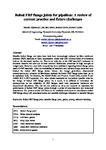Bolted fibre-reinforced polymer flange joints for pipelines: A review of current practice and future challenges
| dc.contributor.author | Aljuboury, Muhsin | |
| dc.contributor.author | Rizvi, MJ | |
| dc.contributor.author | Grove, S | |
| dc.contributor.author | Cullen, Richard | |
| dc.date.accessioned | 2018-04-10T09:00:22Z | |
| dc.date.issued | 2018-04-04 | |
| dc.identifier.issn | 1464-4207 | |
| dc.identifier.issn | 2041-3076 | |
| dc.identifier.uri | http://hdl.handle.net/10026.1/11240 | |
| dc.description.abstract |
<jats:p> Metallic bolted flanges and pipes have both been increasingly replaced by fibre-reinforced polymer materials in many applications which deal with extreme harsh environments such as oil, chemical, marine, etc. This is not only due to the fibre-reinforced polymer material’s resistance to the chemical reaction but also due to their inherent mechanical properties of high strength to weight ratio. However, very little research has been published regarding bolted flange joints made of fibre-reinforced polymer materials. Also, the availability of standards and relevant design codes are very limited for bolted fibre-reinforced polymer flange joints. Hence, the design guidelines, dimensional considerations and selection of fabrication methods for the bolted fibre-reinforced polymer flange joints have yet to be optimized fully. For instance, the ASME Boiler and Pressure Vessel Code, section X and ASME PCC-1-2013 appendix O or other similar standards do not include specific rules for the design of the bolted fibre-reinforced polymer flange joints. As a result, it is difficult to understand the consequences on the reliability of fibre-reinforced polymer flanges made with parametric variations and dimensional alterations. This has led the authors to carry out research to maximise the performance of the bolted fibre-reinforced polymer flange joints through a series of experimenters and numerical simulations. The present article will focus on the available techniques to manufacture the bolted fibre-reinforced polymer flanges along with the associated issues and possible challenges compared to metallic flanges. </jats:p> | |
| dc.format.extent | 1698-1717 | |
| dc.language | en | |
| dc.language.iso | en | |
| dc.publisher | SAGE Publications | |
| dc.subject | Bolted FRP flange joint | |
| dc.subject | metallic flange joint | |
| dc.subject | gasket | |
| dc.subject | piping | |
| dc.subject | adhesive bonding | |
| dc.title | Bolted fibre-reinforced polymer flange joints for pipelines: A review of current practice and future challenges | |
| dc.type | journal-article | |
| dc.type | Review | |
| dc.type | Journal | |
| plymouth.author-url | https://www.webofscience.com/api/gateway?GWVersion=2&SrcApp=PARTNER_APP&SrcAuth=LinksAMR&KeyUT=WOS:000476523700016&DestLinkType=FullRecord&DestApp=ALL_WOS&UsrCustomerID=11bb513d99f797142bcfeffcc58ea008 | |
| plymouth.issue | 8 | |
| plymouth.volume | 233 | |
| plymouth.publication-status | Published | |
| plymouth.journal | Proceedings of the Institution of Mechanical Engineers, Part L: Journal of Materials: Design and Applications | |
| dc.identifier.doi | 10.1177/1464420718766563 | |
| plymouth.organisational-group | /Plymouth | |
| plymouth.organisational-group | /Plymouth/Faculty of Science and Engineering | |
| plymouth.organisational-group | /Plymouth/Faculty of Science and Engineering/School of Engineering, Computing and Mathematics | |
| plymouth.organisational-group | /Plymouth/REF 2021 Researchers by UoA | |
| plymouth.organisational-group | /Plymouth/REF 2021 Researchers by UoA/UoA12 Engineering | |
| plymouth.organisational-group | /Plymouth/Users by role | |
| plymouth.organisational-group | /Plymouth/Users by role/Academics | |
| dcterms.dateAccepted | 2018-03-02 | |
| dc.identifier.eissn | 2041-3076 | |
| dc.rights.embargoperiod | Not known | |
| rioxxterms.versionofrecord | 10.1177/1464420718766563 | |
| rioxxterms.licenseref.uri | http://www.rioxx.net/licenses/all-rights-reserved | |
| rioxxterms.licenseref.startdate | 2018-04-04 | |
| rioxxterms.type | Journal Article/Review |


